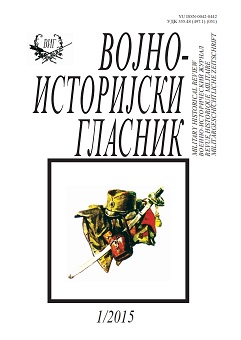Борбе за ослобођење Нове Вароши 3–5. септембра 1941.
The Struggles for the Liberation of Nova Varoš, 3–5 September 1941
Author(s): Milutin ŽivkovićSubject(s): Civil Society, Local History / Microhistory, Military history, Social history, Social differentiation, WW II and following years (1940 - 1949), Sociology of Politics
Published by: Institut za strategijska istraživanja
Keywords: Nova Varoš; uprising; attack; NDH; Serbs; Orthodox; Muslims; Italian army; liberation; 1941; occupation;
Summary/Abstract: The struggle for the liberation of Nova Varoš in early September 1941 stemmed from disaffection of the local Orthodox population, caused by killing, looting, arrests, and mistreatmant by the Croatian regime in the Nova Varoš District. Patriotism was also a factor in this struggle, as well as a desire for liberation, which could been seen in the attack on an shortly after Italians first appeared in this area. Most of the rebel forces were Serbian villagers, who were organized and led by local Communists or Četniks from the Ivanjica and Užice Districts. Only the Orthodox population participated in the uprising. Most of the Muslims remained passive or participated with the occupier in the fighting against the Orthodox. The first attack on Nova Varoš was on 3 September 1941. The action, led by members of the local committee of the Communist Party of Yugoslavia, was spontaneous and poorly planned – and failed. Italian army forces, which occupied Nova Varoš without a fight on 4 September, were a part of the elite 5th Alpine Division "Pusteria," whose soldiers had fought in Ethiopia, France, and Albania. The battalion "Bolzano" had about 1,000 well-equipped men, with many officers. That was probably the cause of the defeat of insurgent forces in the second attack on the town on 5 September 1941. Although this attempt to liberate Nova Varoš was better organized then the first one, as can be seen from the stealthy seizure of strategic positions by the Serbs; a synchronized initial assault that surprised the defenders; the six-hour battle and six attacks on the town, during which the Italian troops suffered losses, it eventually failed. Due to Italian unwillingness to join the comprehensive action against the Orthodox in a Nova Varoš District, most of them kept their arms and quickly re-activated. The struggle in the vicinity of the liberated territory around Užice also prevented the Italians from controlling this battle space. They fled Nova Varoš in early December 1941 when it was liberated by partisan units. Italian occupation authorities returned to the city just seven months later, in mid-1942.
Journal: Vojnoistorijski glasnik
- Issue Year: 2015
- Issue No: 1
- Page Range: 263-278
- Page Count: 16
- Language: Serbian

